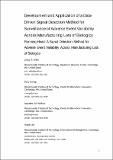| dc.contributor.author | Wilde, Joshua T. | |
| dc.contributor.author | Springs, Stacy | |
| dc.contributor.author | Wolfrum, Jacqueline M. | |
| dc.contributor.author | Levi, Retsef | |
| dc.date.accessioned | 2023-11-09T15:38:18Z | |
| dc.date.available | 2023-11-09T15:38:18Z | |
| dc.date.issued | 2023-09-29 | |
| dc.identifier.uri | https://hdl.handle.net/1721.1/152928 | |
| dc.description.abstract | Abstract
Introduction
Postmarketing drug safety surveillance research has focused on the product-patient interaction as the primary source of variability in clinical outcomes. However, the inherent complexity of pharmaceutical manufacturing and distribution, especially of biologic drugs, also underscores the importance of risks related to variability in manufacturing and supply chain conditions that could potentially impact clinical outcomes. We propose a data-driven signal detection method called HMMScan to monitor for manufacturing lot-dependent changes in adverse event (AE) rates, and herein apply it to a biologic drug.
Methods
The HMMScan method chooses the best-fitting candidate from a family of probabilistic Hidden Markov Models to detect temporal correlations in per lot AE rates that could signal clinically relevant variability in manufacturing and supply chain conditions. Additionally, HMMScan indicates the particular lots most likely to be related to risky states of the manufacturing or supply chain condition. The HMMScan method was validated on extensive simulated data and applied to three actual lot sequences of a major biologic drug by combining lot metadata from the manufacturer with AE reports from the US FDA Adverse Event Reporting System (FAERS).
Results
Extensive method validation on simulated data indicated that HMMScan is able to correctly detect the presence or absence of variable manufacturing and supply chain conditions for contiguous sequences of 100 lots or more when changes in these conditions have a meaningful impact on AE rates. Applying the HMMScan method to FAERS data, two of the three actual lot sequences examined exhibited evidence of potential manufacturing or supply chain-related variability.
Conclusions
HMMScan could be utilized by both manufacturers and regulators to automate lot variability monitoring and inform targeted root-cause analysis. Broad application of HMMScan would rely on a well-developed data input pipeline. The proposed method is implemented in an open-source GitHub repository. | en_US |
| dc.publisher | Springer International Publishing | en_US |
| dc.relation.isversionof | https://doi.org/10.1007/s40264-023-01349-6 | en_US |
| dc.rights | Creative Commons Attribution-Noncommercial-Share Alike | en_US |
| dc.rights.uri | http://creativecommons.org/licenses/by-nc-sa/4.0/ | en_US |
| dc.source | Springer International Publishing | en_US |
| dc.title | Development and Application of a Data-Driven Signal Detection Method for Surveillance of Adverse Event Variability Across Manufacturing Lots of Biologics | en_US |
| dc.type | Article | en_US |
| dc.identifier.citation | Wilde, Joshua T., Springs, Stacy, Wolfrum, Jacqueline M. and Levi, Retsef. 2023. "Development and Application of a Data-Driven Signal Detection Method for Surveillance of Adverse Event Variability Across Manufacturing Lots of Biologics." | |
| dc.contributor.department | Massachusetts Institute of Technology. Operations Research Center | |
| dc.contributor.department | Massachusetts Institute of Technology. Center for Biomedical Innovation | |
| dc.contributor.department | Sloan School of Management | |
| dc.eprint.version | Author's final manuscript | en_US |
| dc.type.uri | http://purl.org/eprint/type/JournalArticle | en_US |
| eprint.status | http://purl.org/eprint/status/PeerReviewed | en_US |
| dc.date.updated | 2023-11-09T04:21:30Z | |
| dc.language.rfc3066 | en | |
| dc.rights.holder | The Author(s), under exclusive licence to Springer Nature Switzerland AG | |
| dspace.embargo.terms | Y | |
| dspace.date.submission | 2023-11-09T04:21:30Z | |
| mit.license | OPEN_ACCESS_POLICY | |
| mit.metadata.status | Authority Work and Publication Information Needed | en_US |
